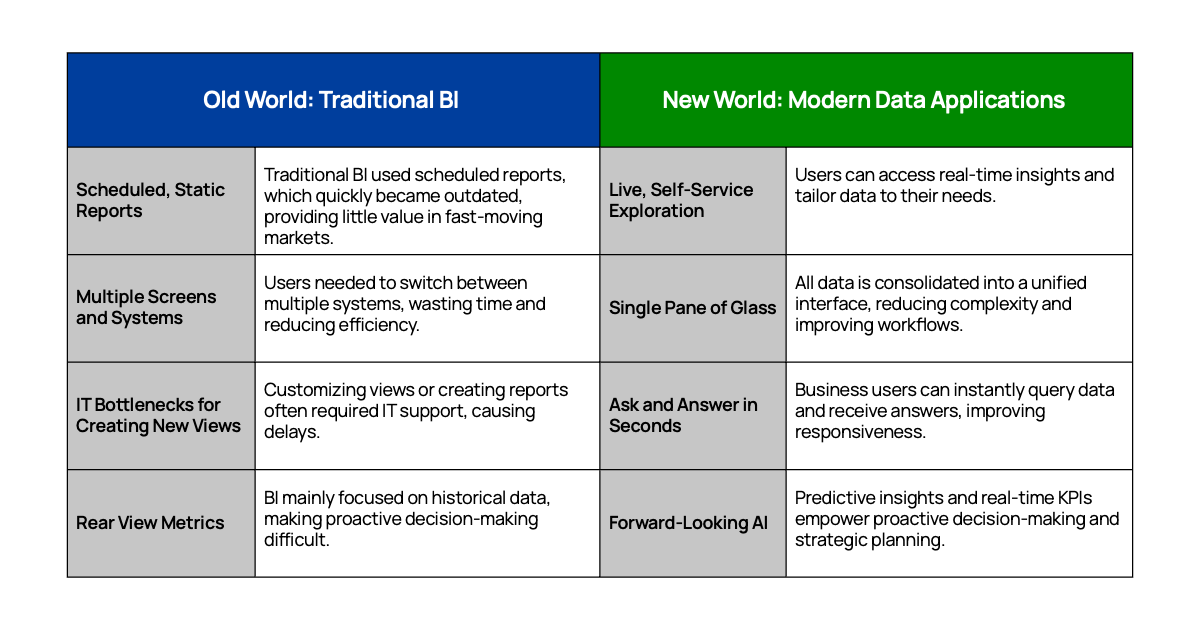Static business intelligence (BI) dashboards no longer suffice for the vast, dynamic data sets of property and casualty (P&C) insurers. As the volume of insurers’ data grows, traditional insights and reporting methods are falling short. According to Capgemini’s latest figures, only 27% of insurance executives believe their firms possess advanced predictive modeling capabilities.
However, the global insurance insights market is still expected to grow at a 14.7% CAGR from 2025 to 2030. Modern, cloud-based data applications (apps) enable real-time, interactive insights, empowering actuaries, underwriters, claims officers, and agents to make faster, more informed decisions.
This depth and speed of information is no longer an advantage for insurers; it’s a strategic necessity.
Why Leverage Modern Data Apps?
Unlike the delayed reports provided by traditional BI systems, modern data apps provide real-time insights, enabling quick, informed decisions during critical events.
Here’s a look at how the “old world” compares to the new world of data applications:

These self-service tools reduce reliance on IT and automate routine tasks, freeing up teams for more strategic work. Modern data apps integrate data from multiple sources, enabling insurers to uncover valuable insights derived from more data than ever before.
Moreover, built-in quality controls and governance ensure that the data is accurate and compliant. Leveraging these tools facilitates a cultural shift toward a more agile, data-driven organization, enabling users across departments to make quicker, informed decisions.
To harness the scale, security, and AI-fueled capabilities offered by modern data apps, insurers need to select the tools and platforms that are right for their organization.
Leading data apps and platforms include:
- The Databricks Data Intelligence Platform offers unified storage and fast deployments for Dash and Streamlit, powered by Spark and MLflow, enabling seamless real-time business intelligence and machine learning workflows.
- Snowflake AI Data Cloud and Cortex AI provide secure data sharing and have Streamlit embedded for easy data exploration. With Snowflake’s AI-powered Copilot integration, these platforms deliver quick, actionable insights using large language models (LLMs).
- Microsoft Fabric and Azure offer an all-in-one studio for data engineering, machine learning, and Power BI, with easy integration to OpenAI, streamlining AI capabilities and data workflows.
- AWS supports serverless data lakes, QuickSight for advanced visualizations, and pre-built insurance data architecture blueprints, allowing insurers to scale quickly while optimizing user experience.
These platforms simplify the complex tasks of data management and AI integration, empowering insurers to focus on delivering actionable insights without worrying about the underlying infrastructure.
5 Ways Modern Data Apps Drive Insurance Growth
While knowing the technology and benefits of modern data apps is critical, where, exactly, can insurers implement this technology to make the strongest impact on their organization?
Here are five high-impact use cases where modern data apps can drive business value and improve overall performance for insurers.

1. Claims Investigation Dashboards
By integrating policy, telematics, and claims data into a singular data app, insurers can create 360° views of claims, apply fraud risk scoring, and facilitate real-time decisioning. This approach significantly reduces cycle times and claims leakage. California Casualty Insurance, for example, uses Guidewire’s Compare product to improve its subrogation recovery in its personal auto line of business.
2. Underwriting Workbenches
Chubb Global Markets deployed an underwriting workbench that consolidates risk information from multiple sources into a single, unified platform. Leveraging modern data capabilities to streamline tasks such as data ingestion, pricing, and compliance checks; integrate data from various systems; and use dynamic dashboards helps reduce manual data entry, improve accuracy, and significantly speed up the decision-making process.
3. Conversational Data Insights Assistants
Conversational insights agents and AI assistants are transforming how underwriters and claims officers interact with data. These AI-powered tools enable users to pose natural language questions, such as “Show me catastrophe loss exposure in Florida this quarter,” and receive instant, advanced visualizations and insights. This self-service capability reduces dependency on IT teams, accelerates decision-making, and empowers staff to access critical information on demand.
4. Data Quality Monitoring Apps
Data quality monitoring is essential for ensuring that data used in reporting and modeling remains accurate and reliable. Brazilian insurer Porto Seguro integrated Atlan’s data quality tools into its workflow to automate anomaly detection, enforce data quality rules, and receive real-time alerts on potential issues. This approach allows the insurer to address data quality problems before they impact decision-making or reporting.
5. Emerging Applications
Innovations like fraud ring detection, catastrophe exposure mapping, and IoT-driven risk models are changing the way insurers address complex challenges. For example, Zurich Insurance leveraged graph insights to enhance fraud detection, visualizing connections between claims and individuals to identify fraudulent activities faster. These technologies help insurers be proactive about risks and streamline operations across the value chain.
As these use cases demonstrate, modern data apps are revolutionizing the way P&C insurers do business. Implementing them effectively will be key to unlocking new efficiencies and opportunities for growth.
Real-Time Data in Action
Data apps are transforming how insurers put their data to use, shifting insights from something that emerge in passive, rear-view reporting into a real-time enabler of strategic action. P&C insurers that embed interactive, AI-powered applications into their operations across the entire insurance value chain, from underwriting to claims, can gain greater agility, sharpen their risk insights, and enhance customer satisfaction.
For insurers seeking to modernize their insights stack, initiating a high-impact pilot, such as a modern claims dashboard or underwriting workbench, is a strong first step. They can then tune and scale the way data apps are used across the enterprise.
To learn more about how data and insights can revolutionize insurance, read our case study, “Erie Insurance Optimizes Data Operations With MarkLogic Enterprise Data Hub on AWS.”




